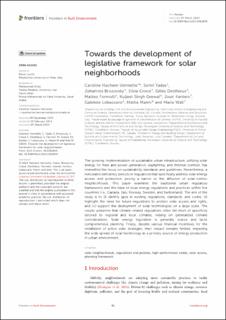| dc.contributor.author | Hachem Vermette, Caroline | |
| dc.contributor.author | Yadav, Somil | |
| dc.contributor.author | Brozovsky, Johannes Georg | |
| dc.contributor.author | Croce, Silvia | |
| dc.contributor.author | Desthieux, Gilles | |
| dc.contributor.author | Formolli, Matteo | |
| dc.contributor.author | Singh Grewal, Kuljeet | |
| dc.contributor.author | Kanters, Jouri | |
| dc.contributor.author | Lobaccaro, Gabriele | |
| dc.contributor.author | Manni, Mattia | |
| dc.contributor.author | Wall, Maria | |
| dc.date.accessioned | 2024-03-08T09:46:56Z | |
| dc.date.available | 2024-03-08T09:46:56Z | |
| dc.date.created | 2024-03-07T13:40:08Z | |
| dc.date.issued | 2024 | |
| dc.identifier.issn | 2297-3362 | |
| dc.identifier.uri | https://hdl.handle.net/11250/3121519 | |
| dc.description.abstract | The growing implementation of sustainable urban infrastructure, utilizing solar energy for heat and power generation, daylighting, and thermal comfort, has intensified the focus on sustainability standards and guidelines. Nevertheless, a noticeable deficiency persists in regulations that specifically address solar energy access and protection, posing a barrier to the diffusion of solar-centric neighborhoods. This paper examines the traditional urban regulatory frameworks and the state of solar energy regulations and practices within five countries (i.e., Canada, Italy, Norway, Sweden, and Switzerland). The aim of the study is to (i) identify gaps in existing regulations, standards, and codes, (ii) highlight the need for future regulations to protect solar access and rights, and (iii) support the deployment of solar technologies on a large scale. The results underline that climate-related regulations often fall short of specificity tailored to regional and local climates, relying on generalized climate considerations. Solar energy legislation is generally scarce and lacks comprehensive planning. Finally, despite various financial incentives for the installation of active solar strategies, their impact remains limited, impeding the wide spread of solar technology as a primary source of energy production in urban environment. | en_US |
| dc.language.iso | eng | en_US |
| dc.publisher | Frontiers | en_US |
| dc.relation.uri | https://doi.org/10.3389/fbuil.2024.1352844 | |
| dc.rights | Navngivelse 4.0 Internasjonal | * |
| dc.rights.uri | http://creativecommons.org/licenses/by/4.0/deed.no | * |
| dc.subject | Solar neighborhoods | en_US |
| dc.subject | Regulations and policies | en_US |
| dc.subject | High-performance codes | en_US |
| dc.subject | Solar access | en_US |
| dc.subject | Planning framework | en_US |
| dc.title | Towards the development of legislative framework for solar neighborhoods | en_US |
| dc.type | Peer reviewed | en_US |
| dc.type | Journal article | en_US |
| dc.description.version | publishedVersion | en_US |
| dc.rights.holder | © 2024 Hachem Vermette, Yadav, Brozovsky, Croce, Desthieux, Formolli, Grewal, Kanters, Lobaccaro, Manni and Wall. | en_US |
| dc.source.volume | 10 | en_US |
| dc.source.journal | Frontiers in Built Environment | en_US |
| dc.identifier.doi | 10.3389/fbuil.2024.1352844 | |
| dc.identifier.cristin | 2252803 | |
| cristin.ispublished | true | |
| cristin.fulltext | original | |
| cristin.qualitycode | 1 | |

